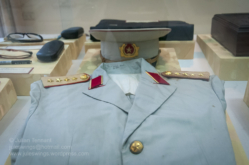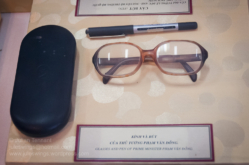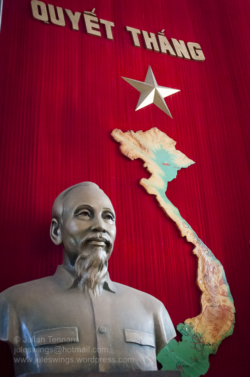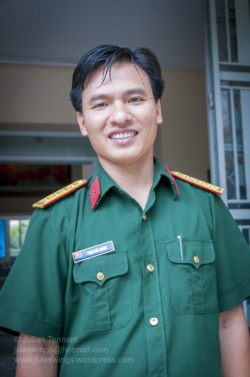The Ho Chi Minh Campaign Museum – HCMC, Vietnam


The Ho Chi Minh Campaign Museum (Bảo tàng Chiến dịch Hồ Chí Minh) is a military museum in Ho Chi Minh City, Vietnam, that recounts the final months of the Vietnam War, culminating in the communist’s victory over the South Vietnamese in April 1975.
The North Vietnamese 1975 Spring Offensive was initially envisioned as a two-stage strategy that would take two years to complete. However, an early victory at Phouc Long (Route 14) on 6 January caused the communists to speed up their offensive. The People’s Army of Vietnam (PAVN) then launched “Campaign 275”, also known as the Central Highlands Campaign, which climaxed in March with the capture of Buon Ma Thuot cutting South Vietnam in two. Surprised by the rapid collapse of the Army of the Republic of Vietnam (ARVN) forces, the communists then turned their attention north, commencing the Hue-Danang Campaign, securing the isolated coastal regions by April 3.

Most of the South Vietnamese army had been routed, but with the communist forces closing in on Saigon, the ARVN made a spirited last stand at the Battle of Xuan Loc, 60km northeast of the capital. Xuan Loc, a vital logistical hub for the South Vietnamese, sat at the intersection of Route 1 and Route 20. They believed that if they could hold there, the situation could be stabilised, their units re-grouped and the country saved from defeat. However, despite the heroic efforts of the ARVN’s 18th Infantry Division, Xuan Loc fell and by 21 April the road to Saigon was open. The PAVN victory at Xuan Loc, allowed the communist forces to encircle Saigon, moving 100,000 troops into positions around the city by April 27.

Despite fierce resistance from troops of the 12th ARVN Airborne Battalion at the Newport Bridge (Cầu Tân Cảng) and from the 81st Ranger Group at Tan Son Nhut, the situation for the South Vietnamese Government had became untenable. At 10:24, on 30 April, South Vietnam’s President Minh announced an unconditional surrender to his troops. Shortly after, at 10:30 after hearing Minh’s orders, the paratroopers at the Newport Bridge stood down allowing the PAVN to cross and at 11:30 PAVN forces entered Tan Son Nhut Air Base after the Rangers also laid down their arms. Around noon, PAVN tanks crashed through the gates of the Independence Palace. Later that afternoon, President Minh publicly announced that the South Vietnamese Government had been dissolved at all levels. The Vietnam War was over.

The Ho Chi Minh Campaign Museum commemorates this successful 1975 offensive by the communists and was established in July 1987. It is housed in a two-story building (that once was the former Republic of Vietnam’s National Defence College) in District 1 close to the Vietnam History Museum and a few blocks away from the famous Notre Dame Cathedral.
The museum is divided into outdoor and indoor display areas, with the outdoor area displaying vehicles, artillery pieces and aircraft related to the campaign including the F5E fighter flown by Nguyen Thanh Trung when he defected from the South Vietnamese Air Force and bombed the Presidential Palace on 8th of April 1975. It also features T54 tank No. 848 of the 203rd Brigade, which was one of the tanks that entered the grounds of the Palace on the 30th of April. Other outdoor exhibits include an M113 APC captured in January during the Phuoc Long Campaign and then subsequently used by the 7th Division for the remainder of the conflict, plus the usual assortment of artillery pieces, wrecked ARVN aircraft and equipment.




Entering the museum building brings visitors into the Ho Chi Minh Campaign rooms. Here, visitors are shown a large ‘mud map’ model giving an overview of the offensive plus other exhibits relating to the final stages of the war such as the official Ho Chi Minh Campaign diary. This is followed by rooms detailing each stage of the offensive, beginning with the Battle for Phuoc Loc (Route 14) and followed by the Tay Nguyen Campaign ( Campaign 275) and the battle for the Central Highlands which resulted in the destruction of ARVN forces in the II Corps zone. The focus then shifts to the Hue-Danang Campaign which isolated then defeated the South Vietnamese troops in I Corps.






The second floor has two main rooms. The first deals with the South Vietnamese high command and ARVN forces including insignia, medals, records and documentation captured from the Army of the Republic of South Vietnam. Other exhibits related to the campaign and activities of the Viet Cong local forces are also shown in the upstairs areas whilst the final room is dedicated to the Ho Chi Minh Campaign Headquarters and leadership group. This includes some unusual collections including several sets of spectacles used by various communist leaders and an old extendable car aerial which is described as the “Swagger-stick of General Tran Van Tra”.






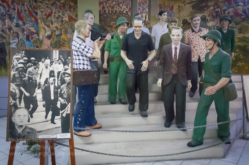

Overall, the museum is well laid out with an interesting selection of exhibits that are accompanied by English language descriptions. However, the victors write the history books and as can be expected, the museum gives a very warped perspective that reflects the communist rhetoric. This is evident in both the language used, with the usual “imperialist puppet troop” type descriptions and also how the artifacts appear. The ARVN and South Vietnamese exhibits always seem to be broken (such as the scrap metal wrecks outside), run-down or looking rather aged and disheveled when compared to the PAVN artifacts which are kept fresh and look almost new. The museum is definitely worth visiting because of the material being displayed, but don’t rely on it giving an accurate representation of the conflict from an even remotely unbiased perspective.
Ho Chi Minh Campaign Museum (Bảo tàng Chiến dịch Hồ Chí Minh)
2 Le Duan Street
District 1
Ho Chi Minh City 70000, Vietnam
Phone: +84 (0)336 578 946
Website (Vietnamese language): Ho Chi Minh Campaign Museum
Open: Monday – Friday 07:30 – 11:00 and 13:30 – 16:30
Note that the museum is frequently closed without notice.
Entrance Fee: Free


